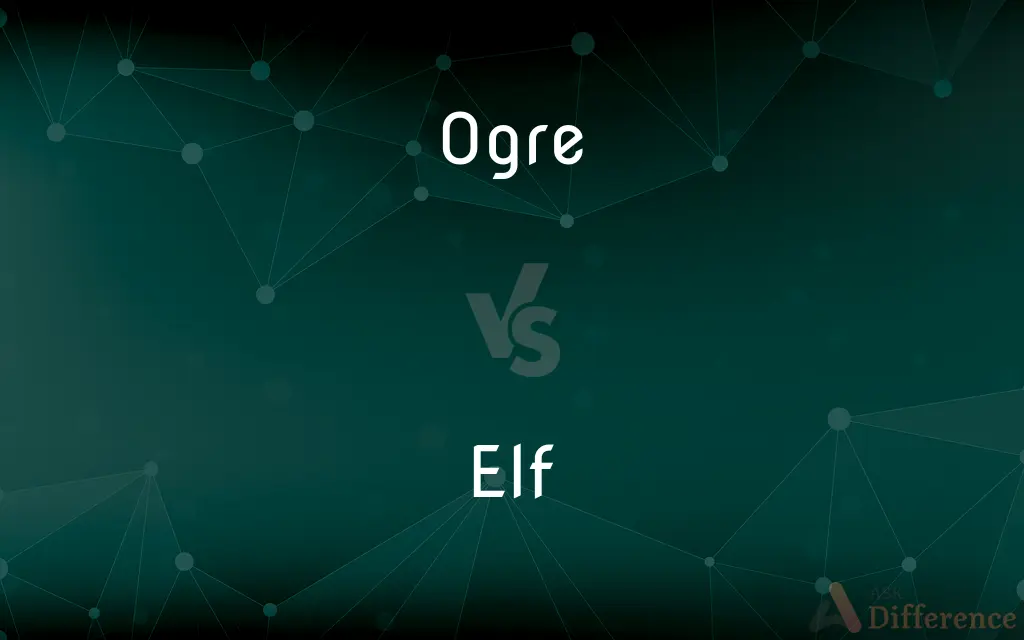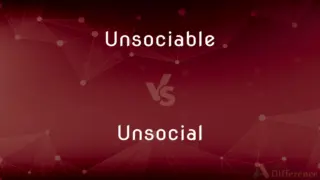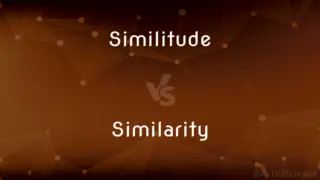Ogre vs. Elf — What's the Difference?
By Urooj Arif & Fiza Rafique — Updated on April 8, 2024
Ogres are mythical creatures often depicted as large, brutish beings prone to aggression, whereas elves are portrayed as slender, graceful beings with a close connection to nature and magic.

Difference Between Ogre and Elf
Table of Contents
ADVERTISEMENT
Key Differences
Ogres in mythology and folklore are typically characterized by their great size, physical strength, and sometimes dim-witted nature, often feared for their aggression towards humans. Elves, on the other hand, are depicted as highly intelligent, immortal beings with an affinity for magic, nature, and artistry, symbolizing grace and wisdom.
While ogres are often portrayed as solitary creatures living in remote areas like swamps or mountains, elves are usually described as living in harmonious communities, deeply connected with the natural world, such as forests or magical realms. This distinction highlights the ogres' association with chaos and destruction, versus the elves' embodiment of harmony and preservation.
In many stories, ogres are antagonists, presenting challenges or threats to heroes, illustrating their role as embodiments of physical obstacles or primal fears. Elves, conversely, often appear as guides, allies, or keepers of ancient wisdom, assisting heroes on their quests with their knowledge and magical abilities.
Culturally, ogres represent the darker aspects of human nature and the unknown, invoking fear and caution. Elves symbolize humanity's aspiration towards harmony, beauty, and intellect, often being idealized representations of perfection in various aspects.
The visual portrayal of ogres and elves also starkly contrasts; ogres are usually depicted with grotesque features, large bodies, and intimidating demeanors, while elves are visualized as aesthetically pleasing, with delicate features and an ethereal presence, reflecting their respective roles in folklore and fantasy.
ADVERTISEMENT
Comparison Chart
Physical Appearance
Large, often grotesque and intimidating.
Slender, graceful, and aesthetically pleasing.
Habitat
Solitary, remote areas like swamps or mountains.
Harmonious communities in nature-rich areas.
Disposition
Aggressive, sometimes dim-witted.
Intelligent, wise, and benevolent.
Role in Mythology
Antagonists, embodying chaos and fear.
Guides or allies, symbolizing harmony and wisdom.
Connection to Nature
Minimal or destructive.
Deeply connected, often guardians of natural realms.
Compare with Definitions
Ogre
A term used to describe a particularly brutish or cruel person.
He was an ogre of a boss, always yelling at his employees.
Elf
In Christmas lore, elves are Santa Claus's helpers, making toys in the North Pole.
The workshop was bustling with elves preparing for Christmas.
Ogre
In certain cultures, ogres represent natural disasters or societal evils.
The ogre in the tale symbolized the destructive power of greed.
Elf
In modern fantasy, elves are often warriors or mages with high intelligence and agility.
My elf mage cast a spell to protect the kingdom.
Ogre
A large, fearsome mythical creature often depicted in folklore as eating humans.
The children were terrified by stories of the ogre living in the woods.
Elf
Elves in literature often symbolize a connection to nature and a higher state of consciousness.
The elves in the novel were guardians of ancient wisdom.
Ogre
In gaming, ogres are typically tank-like characters with high strength and health.
My ogre warrior can withstand a lot of damage.
Elf
Used to describe a person who is clever or mischievous.
She was an elf among her colleagues, always playing pranks.
Ogre
Used metaphorically to describe something daunting or overwhelming.
Facing my debts felt like confronting an ogre.
Elf
A supernatural being in mythology, possessing magical powers and living in forests or other natural places.
The elf offered guidance through the enchanted forest.
Ogre
An ogre (feminine: ogress) is a legendary monster usually depicted as a large, hideous, man-like being that eats ordinary human beings, especially infants and children. Ogres frequently feature in mythology, folklore, and fiction throughout the world.
Elf
An elf (plural: elves) is a type of humanoid supernatural being in Germanic mythology and folklore (especially North Germanic mythology and folklore). In medieval Germanic-speaking cultures, elves generally seem to have been thought of as beings with magical powers and supernatural beauty, ambivalent towards everyday people and capable of either helping or hindering them.
Ogre
(in folklore) a man-eating giant.
Elf
A mythical creature in human form but usually smaller, often considered mischievous.
Ogre
A giant or monster in legends and fairy tales that eats humans.
Elf
A lively, mischievous child.
Ogre
A person who is considered particularly cruel, brutish, or ugly.
Elf
A usually sprightly or mischievous or sometimes spiteful person.
Ogre
(mythology) A type of brutish giant from folk tales that eats human flesh.
Elf
(Norse mythology) A luminous spirit presiding over nature and fertility and dwelling in the world of Álfheim (Elfland). Compare angel, nymph, fairy.
Ogre
(figuratively) A brutish man reminiscent of the mythical ogre.
Elf
Any from a race of mythical, supernatural beings resembling but seen as distinct from human beings. They are usually delicate-featured and skilled in magic or spellcrafting; sometimes depicted as clashing with dwarves, especially in modern fantasy literature.
Ogre
An imaginary monster, or hideous giant of fairy tales, who lived on human beings; hence, any frightful giant; a cruel monster.
His schoolroom must have resembled an ogre's den.
Elf
(fantasy) Any of the magical, typically forest-guarding races bearing some similarities to the Norse álfar (through Tolkien's Eldar).
Ogre
A cruel wicked and inhuman person
Elf
A very diminutive person; a dwarf.
Ogre
(folklore) a giant who likes to eat human beings
Elf
(South Africa) The bluefish (Pomatomus saltatrix).
Elf
To twist into elflocks (of hair); to mat.
Elf
An imaginary supernatural being, commonly a little sprite, much like a fairy; a mythological diminutive spirit, supposed to haunt hills and wild places, and generally represented as delighting in mischievous tricks.
Every elf, and fairy sprite,Hop as light as bird from brier.
Elf
A very diminutive person; a dwarf.
Elf
To entangle mischievously, as an elf might do.
Elf all my hair in knots.
Elf
(folklore) fairies that are somewhat mischievous
Elf
Below 3 kilohertz
Common Curiosities
What is an ogre?
An ogre is a mythical creature often depicted as large and fearsome, notorious for its strength and appetite for humans.
Can elves be evil?
While traditionally seen as benevolent, elves can be portrayed as morally ambiguous or even malevolent in some stories.
What is an elf?
An elf is a mythical being known for its beauty, magical abilities, and deep connection with nature.
Where do ogres live?
Ogres are said to live in remote, often desolate places like mountains, caves, or swamps, away from human settlements.
What is the significance of elves in mythology?
Elves signify a wide range of concepts, from the guardianship of nature to the embodiment of wisdom and the magical.
Are there different types of elves?
Yes, many cultures and fantasy worlds feature different types of elves, such as high elves, wood elves, and dark elves, each with unique traits and habitats.
Do ogres have magical powers?
Typically, ogres are not associated with magic but are known for their physical strength and intimidation.
How are elves depicted in modern fantasy?
In modern fantasy, elves are frequently depicted as wise, long-lived, and skilled in magic and combat, often playing key roles in the narrative.
Do elves age?
Elves are often portrayed as immortal or having extremely long lifespans, aging very slowly if at all.
What role do ogres play in folklore?
Ogres often serve as antagonists or symbols of physical and moral challenges in folklore and fairy tales.
What languages do elves speak?
In many fantasy settings, elves have their own languages, known for their beauty and complexity, reflecting their close ties to magic and ancient history.
How do humans interact with ogres in stories?
Human interactions with ogres are typically adversarial, involving avoidance, trickery, or combat to overcome the threat they pose.
What are common themes in stories featuring ogres?
Common themes include brute strength vs. cunning, the nature of fear, and the triumph of good over evil.
What lessons can be learned from elf mythology?
Elf mythology often teaches about the importance of living in harmony with nature, the value of wisdom and patience, and the complexities of morality.
Can ogres be part of a community?
While traditionally solitary, some stories and games feature ogres as part of mercenary bands, armies, or even communities.
Share Your Discovery

Previous Comparison
Unsociable vs. Unsocial
Next Comparison
Similitude vs. SimilarityAuthor Spotlight
Written by
Urooj ArifUrooj is a skilled content writer at Ask Difference, known for her exceptional ability to simplify complex topics into engaging and informative content. With a passion for research and a flair for clear, concise writing, she consistently delivers articles that resonate with our diverse audience.
Co-written by
Fiza RafiqueFiza Rafique is a skilled content writer at AskDifference.com, where she meticulously refines and enhances written pieces. Drawing from her vast editorial expertise, Fiza ensures clarity, accuracy, and precision in every article. Passionate about language, she continually seeks to elevate the quality of content for readers worldwide.














































